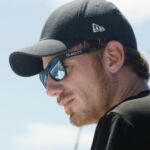
After the very successful expedition to Mauritania in 2016, I joined again for a slightly different mission this time. As we mainly interviewed local fishermen, traders and boat owners during the 2016 expedit ion, this time we set out to try and catch sharks and rays right in the shallow waters of the Banc d’Arguin.
Cover: Releasing a blackchin guitarfish (Glaucostegus cemiculus) in the waters near Iwik after a successful workup and collection of biological samples. Photo by Nina Fieten/University of Groningen
Last year we learned that the fishing pressure on sharks and rays within the Banc d’Arguin (Mauritania, West Africa) is mainly caused by the targeted catches and bycatch of the artisanal fisheries within the park itself. High fishing pressure within the park causes vulnerable species like guitarfishes, Lusitanian cownose rays and hammerhead sharks to be taken in large numbers. The driver behind the fishery? The meat of both sharks and rays is dried for weeks in sand pits and once properly dried, it is exported to Ghana. The fins – being up to 50 times as profitable – are exported to Dakar (Senegal), from where they are flown to Hong Kong. Due to the disappearance of large sharks over the last decades, the fin trade seems to have slowed down within the park, as most of the species left (except guitarfish) do not have large fins. But what does it mean for large intertidal areas like the Banc d’Arguin if sharks and rays disappear? We don’t know, but that is one of the reasons we returned this year.

I joined to teach a local PhD. student how to gather data on live sharks and rays, and to help setup field experiments. We also presented our work from the previous work to the scientific board of the national park in Chami. Over the course of almost three weeks we caught nurse sharks, bull rays, common guitarfish, blackchin guitarfish and marbled stingrays. We also collaborated with local fishermen, by measuring their catches and taking biological samples. These tissue samples will be used for stable isotope and genetic studies, and additional stomach content ‘swipes’ will be used to genetically identify prey species.
Master student Nina Fieten also took on the job as caretaker for a long-legged buzzard (Buteo rufinus) who was sitting in front of the camp. The beautiful bird of prey was weak and did not fly, reason enough to feed it for a couple of days before setting it free.


